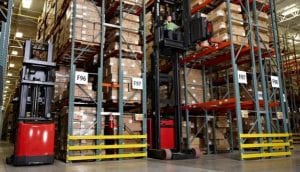What is very narrow aisle (VNA) and what are the considerations when choosing this warehousing method?
VNA is a warehouse design that makes the aisles as narrow as possible while utilizing tall racking systems so as to make material storage as space efficient as possible. In the right application, it can be ideal for both case picking and pallet handling. Let’s look at the things we need to consider.
Floor Flatness
In designing a VNA system for your warehouse, there are several pitfalls that should be avoided. First and foremost is the floor that the racking system is going to be placed on.  Because the pallet racking is placed as closely together as possible and usually quite tall, floor flatness is critical! The taller the racking system, the flatter the host floor needs to be. Imagine a pallet being placed at 40 feet on an uneven floor. Even as little as ¼ inch across the width of the forklift, the pallet could be “leaning” as much as 4 to 5 inches when fully elevated to 40 feet! The Raymond Corporation has certain floor flatness recommendations depending on the height of the highest load beam. They are not difficult to achieve, as long as you plan for them.
Because the pallet racking is placed as closely together as possible and usually quite tall, floor flatness is critical! The taller the racking system, the flatter the host floor needs to be. Imagine a pallet being placed at 40 feet on an uneven floor. Even as little as ¼ inch across the width of the forklift, the pallet could be “leaning” as much as 4 to 5 inches when fully elevated to 40 feet! The Raymond Corporation has certain floor flatness recommendations depending on the height of the highest load beam. They are not difficult to achieve, as long as you plan for them.
Rack Plumbness
Besides the forklift, the pallet rack also needs to be plumb for the same reason. When the pallet racking is installed, the installers need to place a level on each upright and ensure that the plumbness is within 1 inch at 30 feet. The installers are to use rack shims under the rack footplates to make sure the pallet racking is plumb.
Floor Loading Capacity
The floor itself also should be a minimum of 3,000 psi concrete and the reinforcing material (rebar) should be a minimum of 3 to 4 inches below the surface of the concrete and evenly distributed. In today’s new floors, contractors are mixing in ferrous hardening agents in lieu of rebar. The contractors need to make sure that the ferrous hardening agents are distributed evenly throughout the entire floor. If this is not the case, the signal from the wire guidance wire may be diffused and the forklift may lose the wire guidance signal unexpectedly.
Crack Control
If you are going to change the rack design on an existing floor, besides the issues above,  companies need to be aware of the condition of the floor. Are there any cracks? If yes, how large? If the cracks are 3/8 inch or larger at the surface, they need to be repaired with an epoxy grout, equal to or harder than the surrounding concrete. Companies also need to be aware if there are any spots on the floor that would be in the path of the forklifts that have the top surface starting to disintegrate, or spall. This needs to be repaired immediately. Typically, an engineer oversees and specifies the remediation and repair. These repairs range from completely cutting out and re-pouring the damaged section to a troweled-on patch. Without repair, the weight for the forklift will make any area of spalling much worse.
companies need to be aware of the condition of the floor. Are there any cracks? If yes, how large? If the cracks are 3/8 inch or larger at the surface, they need to be repaired with an epoxy grout, equal to or harder than the surrounding concrete. Companies also need to be aware if there are any spots on the floor that would be in the path of the forklifts that have the top surface starting to disintegrate, or spall. This needs to be repaired immediately. Typically, an engineer oversees and specifies the remediation and repair. These repairs range from completely cutting out and re-pouring the damaged section to a troweled-on patch. Without repair, the weight for the forklift will make any area of spalling much worse.
These are a few of the pitfalls that make VNA design and installation more critical than other types of pallet rack systems. When done properly, you’ll watch your capacity, productivity and cost savings multiply. Remember, it’s all in the floor.
Watch this video on Swing Reach trucks for very narrow aisle versatility here.



Great insight to VNA requirements and construction. Thx Bob!